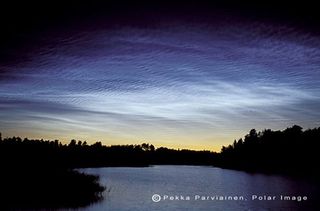Last Shuttle Flight Made Clouds Over Antarctica

Highaltitude clouds were detected over Antarctica shortly after the fateful launchof the space shuttle Columbia. The factthat some of these clouds are born out of shuttle exhaust may require arethinking of their role as a diagnostic for global climate change.
Researchers using satellite and ground-based instrumentstracked the exhaust plume from Columbia's liftoff from Kennedy Space Center inFlorida on Jan. 16, 2003. The plume wasroughly 650 miles long and two miles wide.
"Ouranalysis shows that the Columbia's exhaust plume approached the South Polethree days after launch," said Michael Stevens from the Naval Research Laboratory.
Aswith all shuttle launches, about 97 percent of this exhaust turns into water -a by-product of the liquid hydrogen and liquid oxygen fuel. The resulting 400 tons of extra water in theatmosphere has an observable effect on cloudformation.
Otherrocket launches inject water into the atmosphere, but none so much as theshuttle launch vehicles. Because of lowtemperatures and the high concentrations of water from Columbia's exhaust,Stevens and his colleagues observed a significant increase in polar mesosphericclouds over Antarctica in the days following the launch.
Polar mesospheric clouds - also called noctilucent clouds -form in the summer over the poles at altitudes of about 52 miles (84kilometers), making them the highest clouds in the Earth's atmosphere. They have been monitored in recent yearsbecause they are thought to be sensitive to the temperature and humidity of theatmosphere.
Get the Space.com Newsletter
Breaking space news, the latest updates on rocket launches, skywatching events and more!
"Because the brightness, occurrence, and range of theclouds have been increasing, some scientists have suggested that they areindicators of global climate change," said Xinzhao Chu from the Universityof Illinois at Urbana-Champaign. "That role needs to be reconsidered,however, because of the potential influence of water vapor in shuttleplumes."
Shuttlemissions have been on hold since 2003, after Columbiaand its crew were lost during reentry. The return to flightis scheduled for July 13 of this year.
A paper describing these results appears in the July 6 issueof Geophysical Research Letters.
- Rocket Exhaust Leaves Mark Above Earth
- Ozone-Eating Clouds Form in Cold Polar Rings
- Longer Airline Flights Proposed to Combat Global Warming
Join our Space Forums to keep talking space on the latest missions, night sky and more! And if you have a news tip, correction or comment, let us know at: community@space.com.

Michael Schirber is a freelance writer based in Lyons, France who began writing for Space.com and Live Science in 2004 . He's covered a wide range of topics for Space.com and Live Science, from the origin of life to the physics of NASCAR driving. He also authored a long series of articles about environmental technology. Michael earned a Ph.D. in astrophysics from Ohio State University while studying quasars and the ultraviolet background. Over the years, Michael has also written for Science, Physics World, and New Scientist, most recently as a corresponding editor for Physics.
